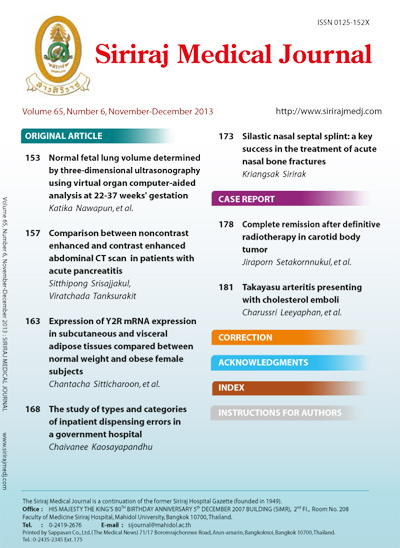Comparison between Noncontrast Enhanced and Contrast Enhanced Abdominal CT Scan in Patients with Acute Pancreatitis
Keywords:
Acute pancreatitis, CT findings of acute pancreatitisAbstract
Objective: To retrospectively compare between non enhanced and enhanced abdominal CT scan and evaluate sensitivity in diagnosis of acute pancreatitis.
Methods: A total of 150 patients diagnosed with acute pancreatitis between January 2008 and December 2011, were enrolled in this study. Abdominal CT images on both precontrast and postcontrast phase in 141 patients (91 male and 50 female, and age range 4-81 years) were retrospectively reviewed. Single non contrast studies were done in 9 of 150 patients. The time period from clinical onset to imaging was within 4 weeks except for 4 patients. Two observers evaluated the CT findings (intraparenchymal, peripancreatic and locoregional findings) of each phase of image separately. The agreement between non contrast and contrast enhanced CT scan of each finding, CT grade and severity were evaluated.
Results: The percentagess of pancreatic CT findings were pancreatic enlargement, abscess, necrosis and pseudocyst at 75.9/75.9%, 11.3/3.5%, 30.5/17.7%, and 6.4/5.7%, compared between Contrast enhanced computed tomography (CECT) and noncontrast enhanced computed tomography (NECT), respectively. The percentages of peripancreatic findings were ir- regular pancreatic outline, obliterated peripancreatic fat, retroperitoneal edema, acute peripancreatic fluid (APFC) and acute necrotic collection (ANC) at 82.3/89.4%, 77.3/85.1%, 18.4/0%, 36.9/44.7% and 32.6/14.9%, respectively. The percentages of locoregional findings were Gerota’s fascia sign, pancreatic ascites, pleural effusion and adynamic ileus at 75.9/85.8%, 61.0/56.7%, 46.8/48.2% and 2.1/0% respectively. About CT grading, grade A (normal CT findings) was found 7.8% and 8.5% on CECT and NECT, respectively. Grade C, D and E were found 36.9/61.7%, 14.9/10.6% and 40.4/19.1%, respectively. Also for severity, mild level was found 44.7/70.2% and severe level was found 55.3/29.8% on CECT and NECT.
Conclusion: Both NECT and CECT scans of the whole abdomen in patients with acute pancreatitis have concordance in interpretation of the CT findings as well as sensitivity in diagnosis. Moreover, NECT has equivalent efficacy in screening of pancreatic abnormality, as compared with CECT. Therefore, we suggest that NECT can be the initial screening modality in patients with acute pancreatitis to confirm diagnosis, severity assessment or evaluation of the complication.
Downloads
Published
How to Cite
Issue
Section
License
Authors who publish with this journal agree to the following conditions:
Copyright Transfer
In submitting a manuscript, the authors acknowledge that the work will become the copyrighted property of Siriraj Medical Journal upon publication.
License
Articles are licensed under a Creative Commons Attribution-NonCommercial-NoDerivatives 4.0 International License (CC BY-NC-ND 4.0). This license allows for the sharing of the work for non-commercial purposes with proper attribution to the authors and the journal. However, it does not permit modifications or the creation of derivative works.
Sharing and Access
Authors are encouraged to share their article on their personal or institutional websites and through other non-commercial platforms. Doing so can increase readership and citations.











